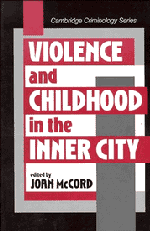Book contents
- Frontmatter
- Contents
- List of Contributors
- Preface
- 1 Violence and the Inner-City Street Code
- 2 The Embeddedness of Child and Adolescent Development
- 3 Placing American Urban Violence in Context
- 4 Neuropsychology, Antisocial Behavior, and Neighborhood Context
- 5 Psychological Mediators of Violence in Urban Youth
- 6 Understanding and Preventing Child Abuse in Urban Settings
- 7 Intervening to Prevent Childhood Aggression in the Inner City
- Name Index
- Subject Index
1 - Violence and the Inner-City Street Code
Published online by Cambridge University Press: 01 June 2011
- Frontmatter
- Contents
- List of Contributors
- Preface
- 1 Violence and the Inner-City Street Code
- 2 The Embeddedness of Child and Adolescent Development
- 3 Placing American Urban Violence in Context
- 4 Neuropsychology, Antisocial Behavior, and Neighborhood Context
- 5 Psychological Mediators of Violence in Urban Youth
- 6 Understanding and Preventing Child Abuse in Urban Settings
- 7 Intervening to Prevent Childhood Aggression in the Inner City
- Name Index
- Subject Index
Summary
Of all the problems besetting the poor inner-city black community, none is more pressing than that of interpersonal violence and aggression. This phenomenon wreaks havoc daily on the lives of community residents and increasingly spills over into downtown and residential middle-class areas. Muggings, burglaries, carjackings, and drugrelated shootings, all of which may leave their victims or innocent bystanders dead, are now common enough to concern all urban and many suburban residents. The inclination to violence springs from the circumstances of life among the ghetto poor – the lack of jobs that pay a living wage, the stigma of race, the fallout from rampant drug use and drug trafficking, and the resulting alienation and lack of hope for the future.
Simply living in such an environment places young people at special risk of falling victim to aggressive behavior. Although there are often forces in the community which can counteract the negative influences – by far the most powerful is a strong, loving, “decent” (as inner-city residents put it) family committed to middle-class values – the despair is pervasive enough to have spawned an oppositional culture, that of “the streets,” whose norms are often consciously opposed to those of mainstream society. These two orientations – decent and street – socially organize the community, and their coexistence has important consequences for residents, particularly for children growing up in the inner city.
- Type
- Chapter
- Information
- Violence and Childhood in the Inner City , pp. 1 - 30Publisher: Cambridge University PressPrint publication year: 1997
- 32
- Cited by



